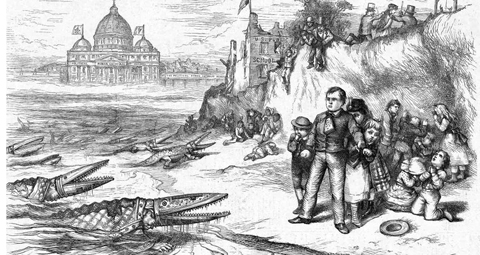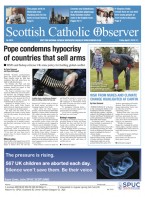September 1 | ![]() 0 COMMENTS
0 COMMENTS ![]() print
print

The US has a long history of hatred
HUGH DOUGHERTY discovers an old Catholic bastion established in a fiercely Protestant culture.
RECENT events in Charlottesville in America’s south proved that hatred still exists in the USA for those who don’t fit the WASP (White, Anglo-Saxon Protestant) mould.
But that should come as no surprise. When the country’s founding fathers framed its constitution, they certainly did not mean: “We hold all men to be created equal.” That meant WASPS only, and certainly not Catholics, Jews, Africans, Hispanics, slaves or, famously, native Americans.
If you don’t believe that, then visit New York’s Old St Patrick’s Cathedral—not today’s St Patrick’s, which tourists know better.
I went to Old St Patrick’s in June, when visiting my son who lives and works in New York, and I was brought up short when it became clear that the city was founded on a Dutch anti-Catholic ethos, one carried on by the British and the Americans which would blight the city for years.
St Patrick’s Old was begun in 1809, one year after the creation of the diocese, which was not without controversy, as the city had enacted anti-Catholic legislation to stay a Catholic-free zone. This was made clear to me during a visit to the Museum of New York, where exhibits record the fiercely Protestant culture of New Amsterdam, the original Dutch settlement, captured and renamed by the British in 1664.
One exhibit, a commemorative, silverware cup, drunk from with gusto by members of anti-Catholic societies, carries the inscription: “Soon they shall all hang by a rope, the priests, the bishops, cardinals and Pope”.
It was against that background that St Patrick’s Old Cathedral was built in Manhattan’s Nolita district.
Opened in 1815, it was later enlarged, burnt down and rebuilt, before taking on a lesser role as a parish church, a function it still discharges today, and always has done despite the 1879 opening of the better-known St Patrick’s.
Old St Patrick’s made American church history in 1875, when the country’s first cardinal, John McCloskey, was invested there, and the event is recalled by a plaque. But a much more sinister set of incidents is recalled on another plaque which gives a flavour of what it was like to be a Catholic in New York in the middle of the 19th century.
That plaque recalls the heroic actions of the Ancient Order of Hibernians (AOH), who were called on by Bishop John Hughes in April 1844 to rally at the cathedral, and fought off a massive, Protestant mob, intent on razing the church to the ground, while screaming anti-Catholic and anti-Irish slogans.
As the plaque puts it, the AOH members rallied to the defence of the cathedral ‘when it was threatened with destruction by the forces of bigotry and intolerance.’
The attack was actually before the great influx of Irish refugees, following the Great Hunger—or perhaps more accurately, the Great Starvation—which saw Irish famine victims flood into New York after 1848.
It shows just how anti-Catholic the city’s culture was. A wall had to be built around Old St Patrick’s to defend the building from further attacks which came straight out of scenes from the film Gangs of New York.
Of course, the Catholic immigrant groups, whether Irish, Italian or Polish, went on to consolidate their place in New York society over the coming 100 years, sadly not without corruption in politics which would make some of the less-scrupulous west of Scotland politicians of the past look like saints. But progress was not always a given.
That was brought home to me when I visited the New York Tenement Museum, where a guide took me through the history of an Irish Catholic family who had lived in the building in the 1870s.
What was really interesting was how they had to fight for their place in the city, but equally interesting was my guide bringing the story up to date.
She recalled the vitriolic opposition from Protestant America to the election of John F Kennedy in 1960, the country’s first Catholic President, showing us a cartoon of Kennedy as an ignorant, Irish pig, too stupid to use a telephone, and she remarked how far the country had come since then.
But, as events have shown in Charlottesville, the WASPS are far from dead, and anyone who may get in their way is in potential danger. It’s a depressing face of a country that has long presented itself as a beacon of hope and equality, and it links the present directly into the world of those who sipped from that anti-Catholic cup in the museum.
But, we should be wary of criticising. Knowing that I came from a Glasgow-Irish background, our tenement museum guide asked me to tell the American guests on our tour how the Glaswegian Irish Catholic experience compared with the family she had been describing.
When I recounted that the monarch could not be Catholic, that there had never been a Catholic Prime Minister, or a Catholic First Minister of Scotland, and that it is only in recent times that the Catholic, Irish community in the west of Scotland has felt confident enough to mark St Patrick’s Day in public, there was a gasp from the Americans.
“Surely not in Scotland?” one American lady exclaimed. But all that is true. Today.










